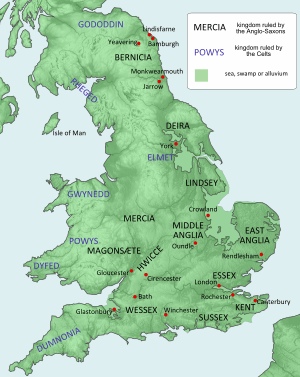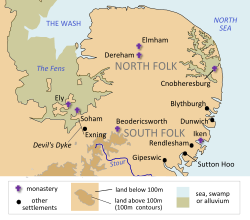Æthelwold of East Anglia facts for kids
Quick facts for kids Æthelwold |
|
|---|---|
| King of the East Angles | |
| Reign | c. 654–664 |
| Predecessor | Æthelhere |
| Successor | Ealdwulf |
| Died | 664 |
| Consort | unknown |
| House | Wuffingas |
| Father | Eni |
Æthelwold (also spelled Æthelwald or Æþelwald) was a king who ruled East Anglia from about 654 to 664. East Anglia was an important Anglo-Saxon kingdom in what is now Norfolk and Suffolk, England.
Æthelwold belonged to the Wuffingas royal family. Their main power center was at Rendlesham. Important places like the Sutton Hoo burial sites, the monastery at Iken, the church center at Dommoc, and the port of Ipswich were all near Rendlesham.
Æthelwold lived during a time of big changes in East Anglia. Earlier Christian kings had died in battles, trying to protect their kingdom from attacks by Mercia. Mercia was led by its pagan king, Penda. Æthelwold was the last of his uncle Rædwald's nephews to rule East Anglia.
He became king after his older brother, Æthelhere, was killed in battle around 655. This battle, called the Battle of the Winwæd, also saw the death of Mercia's King Penda. This event weakened Mercia's power over its neighbors.
During Æthelwold's rule, there were two main Christian traditions in England: the Roman way (from Canterbury) and the Celtic way (from Northumbria). In 664, a meeting called the Synod of Whitby decided that the Roman way would be followed across England.
In 662, Æthelwold helped persuade Swithelm of Essex to become Christian. Swithelm was baptized at Rendlesham, with Æthelwold acting as his sponsor. East Anglia also formed stronger ties with Northumbria and Kent through royal marriages. Æthelwold died in 664 and his nephew, Ealdwulf, became the next king.
Contents
East Anglia's Story
How East Anglia Began

Most of what we know about East Anglia comes from a book called The Ecclesiastical History of the English People. This book was written by a monk named Bede in 731.
East Anglia was a long-lasting kingdom made up of a northern part (now Norfolk) and a southern part (now Suffolk). It formed in the 5th century after the Roman Empire left Britain. People from what is now Germany and Denmark, called Saxons and Angles, settled in eastern Britain.
These settlers brought their own religion and language. Over time, they formed new kingdoms. East Anglia was surrounded by natural barriers like the sea, marshlands, and large rivers. These barriers helped unite the land under one ruling family, the Wuffingas.
Kings Before Æthelwold
The first known king of the East Angles was Rædwald. He ruled from about 599 to 624. Bede wrote that Rædwald became a Christian around 604. He was powerful enough to rule over several other Anglo-Saxon kingdoms.
Rædwald is thought to be buried at Sutton Hoo. A magnificent ship burial was found there, filled with treasures. This shows how important he was.
His son, Eorpwald, ruled briefly but was killed by a pagan named Ricberht. After this, the East Angles went back to paganism for a short time. Then, Sigeberht became king, and Christianity was brought back. During his rule, the church center at Dommoc was set up.
Around 640, the Mercians attacked East Anglia. King Ecgric and his predecessor Sigeberht both died in battle.
Ecgric's successor was Æthelwold's brother, Anna. Anna was known for being very religious. However, he couldn't stop the Mercians from invading East Anglia. Anna was eventually killed by King Penda of Mercia.
Anna's successor was Æthelhere, another brother of Æthelwold. During Æthelhere's rule, Mercia became more powerful than East Anglia. In 655, Æthelhere was killed fighting alongside Penda at the Battle of the Winwæd. After this battle, Penda's son, Peada, became king of Mercia. But Peada was killed a year later. His death was a big setback for Mercia's plans to control other kingdoms.
Rendlesham: A Royal Place
Bede mentioned that Rendlesham was a royal center. This shows how important the area around the Deben river was for the kings. Rendlesham is close to Iken, where Saint Botolph built his monastery. It's also located between the Deben and Alde rivers, near the Butley estuary.
The church in Rendlesham is dedicated to St Gregory. This suggests it had an early connection to the royal family. If the Dommoc church was at Walton, as some believed, then it was also very close to Rendlesham.
Archaeologists have found that the port of Gipeswic (now Ipswich) was growing in importance. It was a center for sea trade with Europe, supported directly by the king.
Æthelwold's Family and Rise to Power
Æthelwold was part of the Wuffingas royal family. He was the youngest son of Eni. His brothers, Anna and Æthelhere, both ruled before him.
The historian William of Malmesbury wrote about Æthelwold becoming king in his book Gesta Regum Anglorum:
- "After Anna, his brother Ethelhere became king. He was rightly killed by King Oswy of Northumbria, along with Penda, because he was helping them. His brother Ethelwald then became king, and later left the kingdom to Adulf and Elwold, the sons of Ethelhere. "
East Anglia had strong ties with the Christian kingdom of Kent through marriages. Seaxburh, the oldest daughter of Æthelwold's brother Anna, was the queen of Eorcenberht of Kent. Seaxburh's sister, Æthelthryth, held an important area in the Fens. Both Kent and this area were strongly connected to the Roman Church.
There was also a link to Northumbria. In 657, Hilda started a monastery at Streoneshalh (now Whitby). This place later became the burial site for Northumbrian kings. Hilda's sister, Hereswitha, married Æthelwold's youngest brother, Æthelric, around 627–629.
Æthelwold's Reign
Christianity in East Anglia
The Celtic Christian tradition had been strong in East Anglia, especially when the monastery of Saint Fursey and Saint Foillan existed at Cnobheresburg. However, the main Christian authority in East Anglia was at Dommoc, which followed the rules of Canterbury.
Saint Botolph started building his monastery at Iken around 653. This was the same year Anna was killed.
King Oswiu of Northumbria convinced Sigeberht II of the East Saxons to be baptized. Cedd, a Northumbrian monk, became Bishop of the East Saxons and helped convert the people. Cedd built monasteries at Tilbury and Ythancæster (now Bradwell-on-Sea).
Sigebert was later killed by his own nobles. He was replaced by the pagan Swithelm of Essex. Cedd convinced Swithelm to become Christian. According to Bede, Swithelm was baptized by Cedd at Rendlesham, with King Æthelwold present as his godfather:
"Sigebert was succeeded in the kingdom by Suidhelm, the son of Sexbald, who was baptized by the same Cedd, in the province of the East Angles, at the king's countryseat, called Rendelsham, that is, Rendil's Mansion; and Ethelwald, king of the East Angles, brother to Anna, king of the same people, was his godfather."
Royal Marriages in East Anglia
In the early 660s, two important marriages took place. Ecgfrith of Northumbria, King Oswiu's son, married Æthelthryth of Ely. Æthelthryth was the daughter of Anna of East Anglia. She was about fourteen years older than Ecgfrith. She chose to remain a virgin for religious reasons during her first marriage and continued this choice as Ecgfrith's wife. This meant they would not have children. Æthelthryth kept Ely as her own property during this marriage.
Meanwhile, Wulfhere of Mercia, Peada's brother, became king of Mercia. He was not Christian at first but soon converted. He married Eormenhilda, the daughter of Eorcenberht of Kent and Seaxburh. Soon after, he founded the monastery of Medeshamstede, which later became known as Peterborough.
The Synod of Whitby
After the death of Finan, a bishop from Lindisfarne, some important figures like Alhfrith of Deira and Wilfred of York wanted King Oswiu to choose the Roman way of Christianity for his kingdoms.
This issue was discussed at the Synod of Whitby in 664. Colmán, Hild, and Cedd argued for the Celtic tradition. Wilfrid spoke for the Roman side. The Roman way won, and the different church authorities were united. Those who couldn't accept this, like Colmán, left.
Around that time, a terrible plague spread across Europe and Anglo-Saxon England. Many people died, including Bishop Cedd, Archbishop Deusdedit of Canterbury, and Eorconbehrt of Kent. King Æthelwold also died in 664.
Quotations


